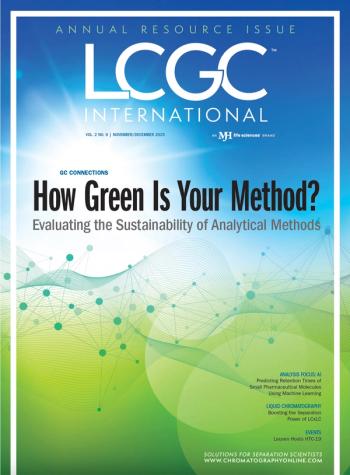
- The Application Notebook-03-02-2010
- Volume 0
- Issue 0
Determination of 25-mono-hydroxy-vitamin D2 and D3 in Human Plasma Using a Symbiosis Pico System: ACN Free On-line SPE-LC–MS–MS
The method developed runs on a fully automated platform integrating solid-phase extraction (SPE) and LC (Symbiosis Pico) without any manual pretreatment step(s). Automatic pretreatment results in high throughput, low CVs and high precision. Sample preparation has been simplified to just one operator step before the system takes over the automated analysis of the samples.
Martin Sibum, Spark Holland bv, Emmen, The Netherlands.
Introduction
The method developed runs on a fully automated platform integrating solid-phase extraction (SPE) and LC (Symbiosis Pico) without any manual pretreatment step(s). Automatic pretreatment results in high throughput, low CVs and high precision. Sample preparation has been simplified to just one operator step before the system takes over the automated analysis of the samples.
Instrumentation
A Spark Holland Symbiosis PICO system with a Mistral column oven and an Applied Biosystems/MDS Analytical Technologies API 4000 LC–MS–MS system are used for this application. The API 4000 is equipped with a Heated Nebulizer (APCI) probe.
Symbiosis Pico is Spark Holland's unique (u)HPLC solution with integrated on-line SPE-LC–MS automation. The system offers large flexibility in processing different types of samples selecting one of the three fully automated operational modes LC; XLC (extraction liquid chromatography) and mXLC (multidimensional on-line SPE)
Experimental
Sample preparation consists of diluting a human sample with a special protein disrupting buffer, followed by mixing. Samples are then placed in the Symbiosis autosampler. 100 μL of sample is injected on a Spark HySphere C8EC-SE sorbent SPE cartridge for on-line sample clean-up and concentration.
The mobile phase consists of formic acid, water and methanol with separation on a Merck KGaA Chromolith SpeedROD RP-18e (endcapped), 50 × 4.6 mm HPLC column. An example chromatogram of the separation achieved is shown in Figure 1.
Figure 1
Results
A calibration curve was created by injecting a full set of calibration standards ranging from 5 to 500 ng/mL spiked human plasma. The calibration curve is calculated with a R2 of 0.999 with a 1/X weighting for both compounds.
Table 1: Accuracy and precision of the QC samples.
Conclusion
This method was evaluated using spiked human sodium heparin plasma samples. The developed on-line SPE-MS–MS method has an absolute recovery of more then 90%, and calibration curve with a linear range from 5–500 ng/mL (R = 0.999 for both compounds). The developed method has an accuracy ranging from 89–117% and precision of 0.1–7.9 %CV. The estimated quantification limits for both analytes are more than sufficient to allow the analytical method to be used for therapeutic drug monitoring. When injecting 100 μL, containing 50 μL of plasma, a detection limit of 5 ng/mL is achieved.
References
1. Spark application note 0053-080-01.
2. Applied Biosystem Vitamin D i-method (User Contributed i-method by Spark).
For more information please send an e-mail to:
Spark Holland bv
P. de Keyserstraat 8, PO box 3887800 AJ Emmen, The Netherlands
E-mail:
Articles in this issue
almost 16 years ago
30-s UHPLC Separation of Pharmaceutical Ingredients using PDA Detectionalmost 16 years ago
Mega-Dalton Protein Complexes Characterizationalmost 16 years ago
BTEX Determination in Gasoline Containing Ethanol by Single Oven MDGCalmost 16 years ago
Virus Particle CharacterizationNewsletter
Join the global community of analytical scientists who trust LCGC for insights on the latest techniques, trends, and expert solutions in chromatography.



